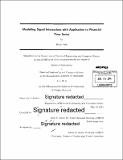| dc.contributor.advisor | John W. Fisher III. | en_US |
| dc.contributor.author | Jain, Bonny | en_US |
| dc.contributor.other | Massachusetts Institute of Technology. Department of Electrical Engineering and Computer Science. | en_US |
| dc.date.accessioned | 2014-11-24T18:38:23Z | |
| dc.date.available | 2014-11-24T18:38:23Z | |
| dc.date.copyright | 2014 | en_US |
| dc.date.issued | 2014 | en_US |
| dc.identifier.uri | http://hdl.handle.net/1721.1/91832 | |
| dc.description | Thesis: M. Eng., Massachusetts Institute of Technology, Department of Electrical Engineering and Computer Science, 2014. | en_US |
| dc.description | Thesis: S.B., Massachusetts Institute of Technology, Department of Electrical Engineering and Computer Science, 2014. | en_US |
| dc.description | Cataloged from PDF version of thesis. | en_US |
| dc.description | Includes bibliographical references (pages 99-100). | en_US |
| dc.description.abstract | In this thesis, we concern ourselves with the problem of reasoning over a set of objects evolving over time that are coupled through interaction structures that are themselves changing over time. We focus on inferring time-varying interaction structures among a set of objects from sequences of noisy time series observations with the caveat that the number of interaction structures is not known a priori. Furthermore, we aim to develop an inference procedure that operates online, meaning that it is capable of incorporating observations as they arrive. We develop an online nonparametric inference algorithm called Online Nonparametric Switching Temporal Interaction Model inference (ONSTIM). ONSTIM is an extension of the work of Dzunic and Fisher [1], who employ a linear Gaussian model with time-varying transition dynamics as the generative graphical model for observed time series. Like Dzunic and Fisher, we employ sampling approaches to perform inference. Instead of presupposing a fixed number of interaction structures, however, we allow for proposal of new interaction structures sampled from a prior distribution as new observations are incorporated into our inference. We then demonstrate the viability of ONSTIM on synthetic and financial datasets. Synthetic datasets are sampled from a generative model, and financial datasets are constructed from the price data of various US stocks and ETFs. | en_US |
| dc.description.statementofresponsibility | by Bonny Jain. | en_US |
| dc.format.extent | 100 pages | en_US |
| dc.language.iso | eng | en_US |
| dc.publisher | Massachusetts Institute of Technology | en_US |
| dc.rights | M.I.T. theses are protected by copyright. They may be viewed from this source for any purpose, but reproduction or distribution in any format is prohibited without written permission. See provided URL for inquiries about permission. | en_US |
| dc.rights.uri | http://dspace.mit.edu/handle/1721.1/7582 | en_US |
| dc.subject | Electrical Engineering and Computer Science. | en_US |
| dc.title | Modelling signal interactions with application to financial time series | en_US |
| dc.title.alternative | Time series inference with Gibbs sampling : filtering approach and financial applications | en_US |
| dc.type | Thesis | en_US |
| dc.description.degree | M. Eng. | en_US |
| dc.description.degree | S.B. | en_US |
| dc.contributor.department | Massachusetts Institute of Technology. Department of Electrical Engineering and Computer Science | |
| dc.identifier.oclc | 894230293 | en_US |
